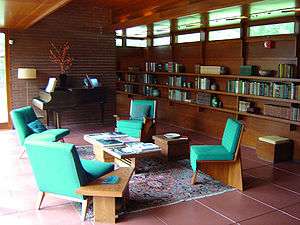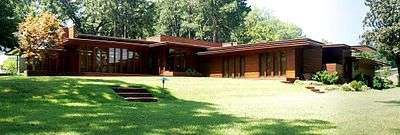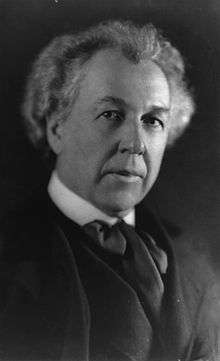Rosenbaum House
The Rosenbaum House is a single-family house designed by architect Frank Lloyd Wright and built for Stanley and Mildred Rosenbaum in Florence, Alabama. A noted example of his Usonian house concept, it is the only Wright building in Alabama,[2] and is one of only 26 pre-World War II Usonian houses. Wright scholar John Sergeant called it "the purest example of the Usonian."[3]
Rosenbaum House | |
 The living room | |
  | |
| Location | 601 Riverview Dr., Florence, Alabama |
|---|---|
| Coordinates | 34°47′34″N 87°40′49″W |
| Built | 1940 |
| Architect | Frank Lloyd Wright |
| Architectural style | Usonian |
| Part of | McFarland Heights |
| NRHP reference No. | 78000492[1] |
| Added to NRHP | December 19, 1978 |
History
In 1938 newlyweds Stanley Rosenbaum (a professor at Florence State Teachers' College) and his wife Mildred were given a building lot and funds to build a house in Florence, Alabama. Both had read Frank Lloyd Wright's autobiography and a cover story on Wright in Time magazine. The Rosenbaums took up residence in September 1940 and the first photographs of the house were exhibited at the Museum of Modern Art in New York City the following month. This house was also the childhood home of notable American film critic Jonathan Rosenbaum.
Restoration
The house was placed on the National Register of Historic Places in 1978.[1] It remained in the Rosenbaum family until 1999 (when Mildred Rosenbaum moved into a nursing home), longer than any of Wright's other Usonian clients. By this time the house was in poor repair, with extensive water penetration and termite damage. The Rosenbaum family donated the house to the City of Florence and at the same time sold the furniture and contents of the house to the city for $75,000. The city spent a further $600,000 on repairs, using original plans sent by the archives of the Frank Lloyd Wright Foundation at Taliesin West.[4] The Wright Archive is currently the Frank Lloyd Wright Foundation Archives at the Avery Architectural and Fine Arts Library of Columbia University in New York City.[5] The city opened the house as a public museum, the Frank Lloyd Wright Rosenbaum House, in 2002. The museum displays some of the original Wright designed furniture, and won the 2004 Wright Spirit Award in the Public Domain from the Frank Lloyd Wright Building Conservancy.[4] Mildred Rosenbaum was the first recipient of the Wright Spirit Award[6] for her tireless efforts through the Frank Lloyd Wright Rosenbaum House Foundation. In her last five years in residence, which ended in 1998, nearly 5,000 visitors received personal tours conducted by Mrs. Rosenbaum, who died in 2006.[7]
Architecture
The Rosenbaum House was the first of dozens of Wright's Usonian houses based on the 1936 Usonian prototype Jacobs House in Madison, Wisconsin. The house was built on a 2-acre (8,100 m2) plot at 117 Riverview Drive (now 601 Riverview, after renumbering), on the north bank of the Tennessee River.[8] Built in an L-shape, the house is made from natural materials, largely cypress wood and brick, and features multilevel low-rising steel-cantilevered roofs covering both the living spaces and an adjoining carport. A distinctive feature of the house is its glass; USA Today described it as "blurring the distinction between indoors and outdoors."[2] Most of the rooms have their own door to the outside. The center of the house is the "service core", built around a large stone hearth and adjacent to a 100 square foot (9.3 m2) study.[9][10]
The original Usonian floorplan provided 1,540 square feet (143 m2) of living space, but when the Rosenbaums had their fourth child they asked Wright to design an extension to the now cramped house. His modifications, completed in 1948, added a further 1,084 square feet (100 m2) in a second L-shape.


Recognition
It is listed on the National Register of Historic Places individually, and also as a contributing building in the McFarland Heights historic district.
References
- "National Register Information System". National Register of Historic Places. National Park Service. April 15, 2008.
- Bleiberg, Larry (June 7, 2015). "10 Great: Frand Lloyd Wright Homes". USA Today.
- "Rosenbaum House". Great Buildings. Artifice. Archived from the original on January 1, 2014. Retrieved December 30, 2013.
- Hertzberg, Mark (February 3, 2006). "Restoring the Rosenbaum House". The Journal Times. Racine, Wis. Archived from the original on April 23, 2009. Retrieved December 30, 2013.
- https://guides.library.columbia.edu/frank-lloyd-wright
- https://savewright.org/what-we-do/wright-spirit-awards/
- "Mildred Rosenbaum". TimesDaily. Florence, Ala. October 12, 2006. Archived from the original on December 31, 2013. Retrieved December 30, 2013.
- "The Frank Lloyd Wright Rosenbaum House". Visit Florence. Archived from the original on January 1, 2014. Retrieved December 30, 2013.
- Mertins, Ellen; Stanley Rosenbaum; Mildred Rosenbaum (October 24, 1978). "Rosenbaum House". National Register of Historic Places Inventory-Nomination Form. National Park Service. Archived (PDF) from the original on December 30, 2013. Retrieved December 30, 2013. See also: "Accompanying photos". Archived (PDF) from the original on December 30, 2013. Retrieved December 30, 2013.
- "Usonian House - Exterior". The Life and Work of Frank Lloyd Wright. PBS. Archived from the original on February 28, 2014. Retrieved December 30, 2013.
- Rosenbaum, Alvin. Usonia: Frank Lloyd Wright's Design for America. Washington: The Preservation Press, 1993, ISBN 0-471-14430-4.
- Storrer, William Allin. The Frank Lloyd Wright Companion. University Of Chicago Press, 2006, ISBN 0-226-77621-2 (S.267).


